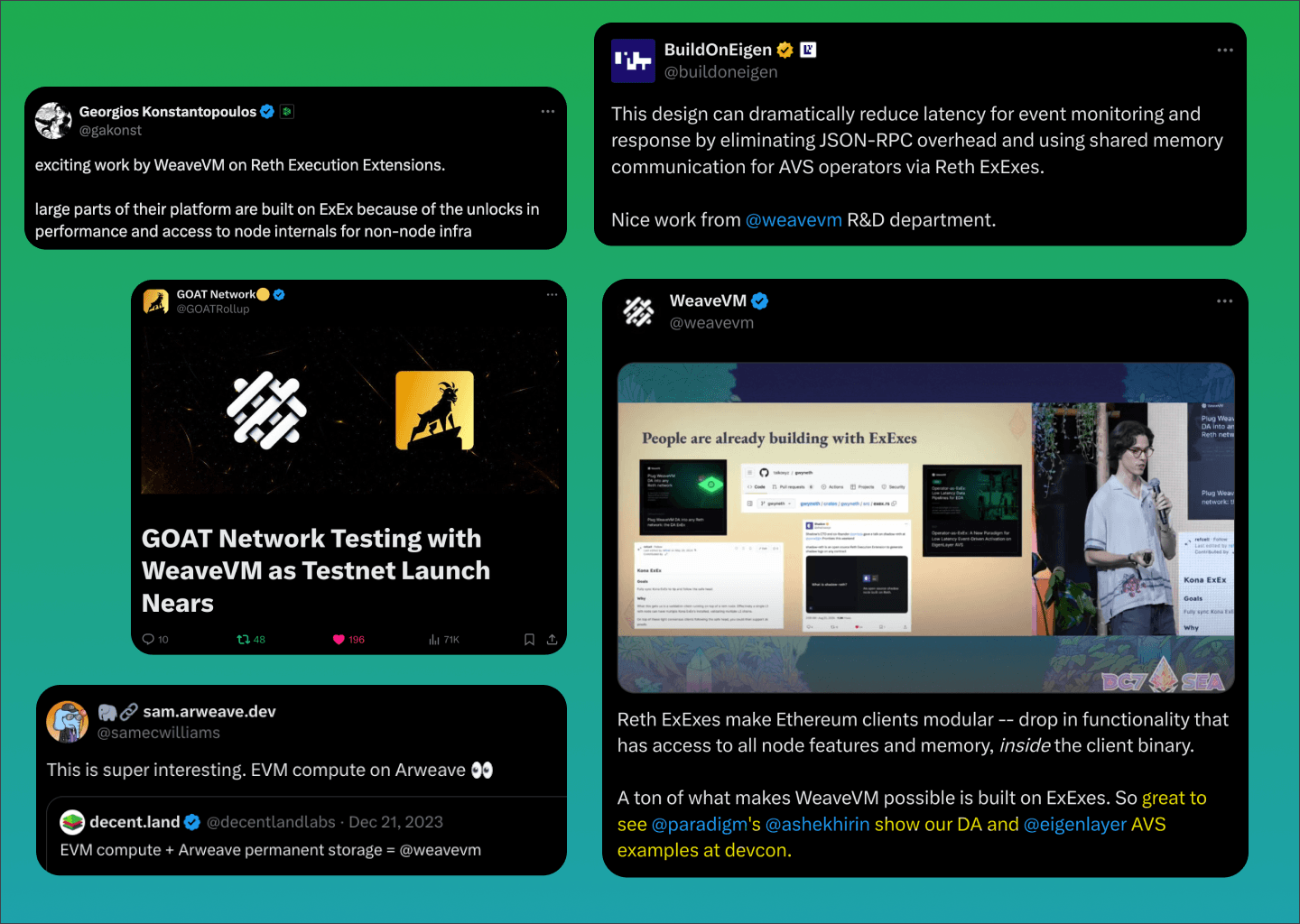As the snow falls softly on validator nodes worldwide, with 2024 behind us, let’s warm ourselves with memories of a year spent building. While the crypto world was busy writing its yearly predictions, our team spent 2024 in the cozy glow of the terminal, solving blockchain’s storage problem one commit at a time. Here’s what kept our screens glowing this year – the code we shipped, the chains we helped, and how we’re making permanent storage accessible to all.
The Numbers That Matter
Starting from zero, our testnet grew into something that started looking a lot more like mainnet. Over 67,000 users began building and testing. More than 2 million transactions flowed through the system. The network posted 2.6 million transactions to Arweave, each one proving that permanent storage doesn’t have to be a luxury.
We hit 100k daily transactions from data settlement for L2s like Metis, RSS3, GOAT Network and Dymension, in preparation to serve the coming generation of high performance chains. Fun fact: WeaveVM could handle settlement for over 10,000 instances of OP Mainnet in parallel before reaching capacity.
Breaking the EVM Storage Barrier
The blockchain world has gotten used to impossible EVM storage costs. When you’re paying over $800 per megabyte, nobody’s storing anything on-chain. The economics simply don’t work. We changed that equation entirely.
Through a combination of technical innovations and smart architecture choices, we brought that $800/MB down to $0.05/MB. Not by cutting corners or moving things off-chain, but by building with the right foundation:
We implemented the first Arweave-EVM gaseconomics system, doubling the contract size limits so developers could actually build what they needed.
Alphanet V3: 800x Faster Queries, Tags
The Lovelace upgrade landed in December, marking Alphanet V3’s arrival without requiring a hard fork or state reset. We transformed Arweave GraphQL performance, cutting query times from 25s to 30ms - an 800x improvement that pushed our 0x17 precompile success rates to 80-90% at 1s blocktime.
The upgrade delivered WeaveVM Transaction Tags for enhanced data protocols and onchain indexing, while our ARIO integration brought faster gateway performance and optimistic data retrieval. Most notably, we’ve sustained active data throughput at 93-125 KBps of data ingress (186-250 KBps with encoding) - matching or exceeding the combined throughput of all rollups on rollup.wtf.
Speed Matters
In 2024, block times dropped from 2 seconds to 1 second. Data throughput jumped from 9.375 MBps to 62 MBps – a 5.6x increase that changed what’s possible on-chain. Perhaps most importantly, we made Arweave GQL requests 800x faster, taking them from 25 seconds to just 30 milliseconds.
These aren’t just numbers. Each improvement means developers can build things that weren’t possible before. When you can query data in milliseconds instead of seconds, entire new categories of applications become viable.
A Quiet Leap Forward in Infrastructure\
Behind these user-facing improvements, we’ve been relentlessly improving the infrastructure that makes everything work. The 0x21 precompile brought native KYVE blob data access. The [0x20] precompile made historical block access actually practical. The wvm:// protocol turned complex data retrieval into something developers could actually use.
The WeaveVM Reth repo grew by 111 PRs, each one making the system stronger. The 0x18 precompiles started hitting 80-90% success rates at 1-second blocktime. We refactored the ExEx for performance and contributed back upstream to reth v.1.1.1.
Cross-Chain Compatibility
2024 was about making our WeaveVM more versatile and accessible. The WeaveVM Archiver v0.2.5 introduced support for Substrate chains, alongside significant performance improvements like parallel backfill and live sync. These additions mean projects built on Polkadot and similar ecosystems can now use the same archiver infrastructure to solve their storage problems.
Industry Recognition
Paradigm’s recognition of our approach to blockchain storage validated what we’d been building. But more importantly, it showed that the industry was ready for real solutions to the storage problem.
Industry leaders started taking note of what permanent, affordable storage could mean for the ecosystem. For WeaveVM, 2025 is going to be about pushing that conversation forward from “can we afford to store this onchain?” to “what can we build now that storage actually works?“.
Real Projects, Real Impact
The true value of infra is in what people build with it. Throughout 2024, we saw significant adoption across the ecosystem.
- Metis: Integrated for permanent data storage, backed by a strong community vote of 15,000 METIS tokens
- KYVE: Enabled native access to archived Ethereum blobs directly from the smart contract layer through our 0x21 precompile
- RSS3: Leveraged affordable permanent storage to transform social protocol infrastructure
- Humanode: Chose WeaveVM for next-generation data settlement needs
- Dymension: Selected WeaveVM to scale their data availability solution
- GOAT Network: Migrated their node to Testnet3, pioneering new architectures for rollup data availability
Building for the Future
SEDA joined as our first oracle provider, rolling out storage price feeds and bringing datasets on-chain. Our hot caching feature development promises to make data access even faster. Multiple L1s and L2s are already using us for data settlement, with more dropping in December and January. Read the full SEDA announcement here.
Looking Forward
With 2024 behind us, our foundation is solid and the vision for the road ahead is clear. The technology is proven. Real projects are building real solutions. Discussions are heating up, massive collaborations are in the pipeline, and partnership announcements are coming.
But the bigger story is what this enables. When storage stops being the limiting factor, developers can finally build what they’ve always wanted to build. That’s our resolution for 2025.
Want to verify these numbers? Check the explorer. Want to build something? The docs are waiting.



